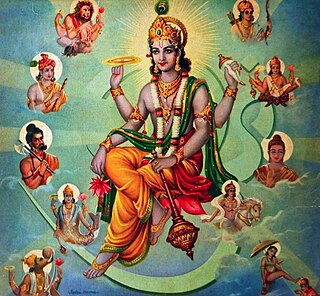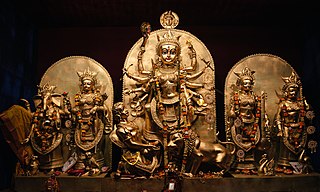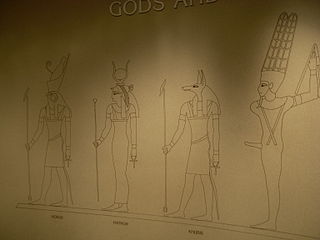Atheism is, in a broad sense, the lack of belief in the existence of deities. In a narrower sense, atheism is simply the absence of belief that any deities exist. This is a compilation of the various lists of atheists with articles on Wikipedia by category. Living people in these lists are those whose atheism is relevant to their notable activities or public life, and who have publicly identified themselves as atheists.

Theism is broadly defined as the belief in the existence of at least one deity. In common parlance, or when contrasted with deism, the term often describes the philosophical conception of God that is found in classical theism—or conception found in monotheism—or gods found in polytheistic religions—or a belief in God or gods without the rejection of revelation as is characteristic of deism.

Mesopotamian religion was the original religious beliefs and practices of the civilizations of ancient Mesopotamia, particularly Sumer, Akkad, Assyria and Babylonia between circa 6000 BC and 400 AD. The religious development of Mesopotamia and Mesopotamian culture in general, especially in the south, were not particularly influenced by the movements of the various peoples into and throughout the area. Rather, Mesopotamian religion was a consistent and coherent tradition, which adapted to the internal needs of its adherents over millennia of development.

In Sabine and ancient Roman religion and myth, Luna is the divine embodiment of the Moon. She is often presented as the female complement of the Sun, Sol, conceived of as a god. Luna is also sometimes represented as an aspect of the Roman triple goddess, along with Diana and either Proserpina or Hecate. Luna is not always a distinct goddess, but sometimes rather an epithet that specializes a goddess, since both Diana and Juno are identified as moon goddesses.

Hindu deities are the gods and goddesses in Hinduism. Deities in Hinduism are as diverse as its traditions, and a Hindu can choose to be polytheistic, pantheistic, monotheistic, monistic, even agnostic, atheistic, or humanist. The terms and epithets for deities within the diverse traditions of Hinduism vary, and include Deva, Devi, Ishvara, Ishvari, Bhagavān and Bhagavati.
A tutelary is a deity or a spirit who is a guardian, patron, or protector of a particular place, geographic feature, person, lineage, nation, culture, or occupation. The etymology of "tutelary" expresses the concept of safety and thus of guardianship.
Transtheism refers to a system of thought or religious philosophy that is neither theistic nor atheistic, but is beyond them. The word was coined by either theologian Paul Tillich or Indologist Heinrich Zimmer.

A pantheon is the particular set of all gods of any individual polytheistic religion, mythology, or tradition.
Rigvedic deities are deities mentioned in the sacred texts of Rigveda, the principal text of the historical Vedic religion of the Vedic period.

This is a list of various lists of Hindus related topics grouped under related sections.

Polytheism the belief or worship of more than one god. According to Oxford Reference, it is not easy to count gods, and so not always obvious whether an apparently polytheistic religion, such as Chinese Folk Religions, is really so, or whether the different apparent objects of worship are to be thought of as manifestations. Polytheistic belief is usually assembled into a pantheon of gods and goddesses, along with their own religious sects and rituals. Polytheism is a type of theism. Within theism, it contrasts with monotheism, the belief in a singular God who is, in most cases, transcendent.
The following are lists of demons:

In ancient Roman religion, the indigitamenta were lists of deities kept by the College of Pontiffs to assure that the correct divine names were invoked for public prayers. These lists or books probably described the nature of the various deities who might be called on under particular circumstances, with specifics about the sequence of invocation. The earliest indigitamenta, like many other aspects of Roman religion, were attributed to Numa Pompilius, second king of Rome.

A deity or god is a supernatural being considered to be sacred and worthy of worship due to having authority over the universe, nature or human life. The Oxford Dictionary of English defines deity as a god or goddess, or anything revered as divine. C. Scott Littleton defines a deity as "a being with powers greater than those of ordinary humans, but who interacts with humans, positively or negatively, in ways that carry humans to new levels of consciousness, beyond the grounded preoccupations of ordinary life".
This is an index to deities of the different religions, cultures and mythologies of the world, listed by region or culture.
An = Anum, also known as the Great God List, is the longest preserved Mesopotamian god list, a type of lexical list cataloging the deities worshiped in the Ancient Near East, chiefly in modern Iraq. While god lists are already known from the Early Dynastic period, An = Anum most likely was composed in the later Kassite period.
Weidner god list is the conventional name of one of the known ancient Mesopotamian lists of deities, originally compiled by ancient scribes in the late third millennium BCE, with the oldest known copy dated to the Ur III or the Isin-Larsa period. Further examples have been found in many excavated Mesopotamian cities, and come from between the Old Babylonian period and the fourth century BCE. It is agreed the text served as an exercise for novice scribes, but the principles guiding the arrangement of the listed deities remain unknown. In later periods, philological research led to the creation of extended versions providing explanations of the names of individual deities.






